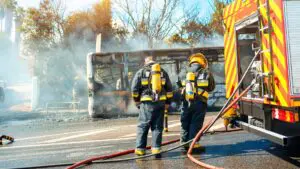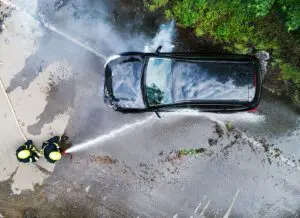The moments after a car accident are chaotic and disorienting. Among the many hazards that might follow a collision, vehicle fires represent one of the most dangerous and rapidly escalating threats. Each year, thousands of Americans experience vehicle fires after crashes, with these incidents accounting for approximately one-fifth of all highway vehicle fires.
When a vehicle catches fire after a collision, occupants face not only the initial trauma of the car crash but also the immediate threat of toxic smoke inhalation, severe burns, and potentially fatal entrapment. Having just seconds to react, understanding the warning signs, and proper evacuation procedures can mean the difference between life and death.
Whether you’re a daily commuter, occasional driver, or passenger, knowing how vehicle fires start, spread, and can be prevented is essential knowledge that could save your life or the lives of others. If you were in a car accident and were severely injured by a car fire, the car accident lawyers at Munley Law can help. Contact us today to schedule a free consultation.
Common Causes of Post-Accident Vehicle Fires
 Vehicle fires rarely happen without reason—they typically result from mechanical failures during or immediately after a collision. Fuel system damage represents the primary ignition source in post-accident vehicle fires. Modern vehicles carry highly flammable gasoline or diesel fuel in reinforced tanks, but a severe impact can rupture these containers or the lines connecting them to the engine. When fuel escapes and contacts hot engine components—which can remain above 800°F even after the engine stops running—ignition often follows rapidly.
Vehicle fires rarely happen without reason—they typically result from mechanical failures during or immediately after a collision. Fuel system damage represents the primary ignition source in post-accident vehicle fires. Modern vehicles carry highly flammable gasoline or diesel fuel in reinforced tanks, but a severe impact can rupture these containers or the lines connecting them to the engine. When fuel escapes and contacts hot engine components—which can remain above 800°F even after the engine stops running—ignition often follows rapidly.
When damaged, the electrical systems in today’s vehicles also present significant fire hazards. A typical car contains miles of wiring carrying electrical current throughout the vehicle. When crashes damage this wiring, exposed conductors can create sparks capable of igniting nearby materials. Damaged batteries pose additional risks, as they contain corrosive chemicals and can generate hydrogen gas when compromised.
Engine components themselves can serve as ignition sources. Catalytic converters, exhaust manifolds, and turbochargers operate at extremely high temperatures during normal driving. After a collision, these superheated parts may come into contact with flammable materials dislodged from their normal positions, creating perfect conditions for a fire to start.
Different vehicle types present unique fire risks. Conventional gasoline-powered vehicles contain obvious fire hazards in their fuel systems. Hybrid vehicles combine these risks with those of high-voltage electrical systems. While lacking traditional fuel, electric vehicles contain large battery packs that can experience “thermal runaway” when damaged. This chain reaction generates intense heat and is difficult for firefighters to extinguish.
The crash environment itself may introduce additional ignition sources. Metal scraping against pavement creates sparks. Damaged roadside infrastructure like electrical boxes may expose live wires. Even spilled cargo from the vehicles involved can introduce unexpected fire hazards to the scene.
What Else Causes a Vehicle Fire?
Car accidents are not the only cause of a vehicle fire. Other factors that can cause a vehicle fire include:
- Mechanical Failures: Fuel and electrical system components can fail without an accident. Deteriorated fuel lines, faulty wiring, battery terminal corrosion, worn gaskets, or leaking fuel injectors can allow fuel to contact hot engine parts. Oil and fluid leaks can be flammable.
- Product Defects: Vehicle manufacturers have a responsibility to design and produce vehicles that meet safety standards and are free from unreasonable fire hazards. When they fail to do so, they may be held liable for resulting damages. A product liability attorney can help with your claim.
- Improper Maintenance: Skipping regular maintenance allows small problems to develop into serious fire hazards. Accumulated oil and grease in the engine compartment provide additional fuel for fires to spread once ignited.
- Aftermarket Modifications: Improperly installed aftermarket parts—especially those affecting the electrical system or engine performance—can create fire hazards. Custom lighting, audio systems, and performance chips are common culprits when not installed correctly.
- Parking Over Flammable Materials: The underside of a vehicle, particularly the catalytic converter, becomes extremely hot during operation. Parking over dry grass, leaves, or other combustible materials can ignite these substances.
- Improper Cargo Transport: Carrying flammable liquids or materials improperly secured in the passenger compartment or trunk poses significant risks. Even seemingly innocent items like pool chemicals can react and generate heat that leads to fires.
- Rodent Damage: Mice, rats, and other rodents sometimes nest in engine compartments and chew through wiring insulation, creating short circuit risks.
Warning Signs of a Vehicle Fire Following a Car Accident
Recognizing the early warning signs of a vehicle fire can provide the extra seconds needed for safe evacuation. Take immediate action if you notice any of these signs following an auto accident:
- Smoke or steam rising from any part of the vehicle
- Unusual odors, particularly the smell of gasoline, burning plastic, or hot electrical components
- Unexpected sounds like popping, hissing, or crackling
- Fluid leaks
- Electrical malfunctions like flickering dashboard lights
If you see any of these signs, turn off the engine immediately if it’s still running. This step alone can significantly reduce fire risk by eliminating active fuel pumping and electrical current flow.
Next, focus on leaving the car as fast as possible. Unbuckle seat belts and check quickly for the fastest exit routes. If doors won’t open, windows become the next evacuation option. If you don’t have a tool, such as an emergency window breaker, use the metal post of your headrest or a heavy, pointed object you can find. Hit one of your side windows, they are easier to break than the windshield.
Once outside, move at least 100 feet away from the vehicle, preferably upwind of any smoke or fumes, and help others reach this safe distance.
Only after ensuring your safety and the safety of others should you call emergency services. Provide clear information about your location and mention that the accident involves a vehicle fire or potential fire situation.
Can a Fire Be Prevented After a Car Accident?
 While not all accidents can be avoided, proper maintenance and preparation can prevent many vehicle fires. Regular vehicle inspections significantly reduce fire risks from mechanical failures.
While not all accidents can be avoided, proper maintenance and preparation can prevent many vehicle fires. Regular vehicle inspections significantly reduce fire risks from mechanical failures.
Pay particular attention to these maintenance areas:
- Fuel system integrity: Have fuel lines, connections, and tanks checked annually for wear or damage
- Electrical system health: Address check engine lights promptly and have batteries professionally inspected
- Fluid leaks: Repair even small leaks of oil, transmission fluid, or power steering fluid
- Engine compartment cleanliness: Keep engine areas free from built-up oil and debris
Beyond maintenance, equipping your vehicle with safety tools provides additional protection. Consider adding these items to your vehicle:
- A properly rated fire extinguisher (ABC or BC type) secured in an accessible location
- A combination seat belt cutter and window breaker tool
- First aid supplies, including burn treatment materials
- Emergency contact information and medical details for all regular passengers
Modern vehicles include numerous fire prevention technologies. Inertia switches automatically cut fuel flow during crashes, battery disconnect systems isolate electrical power, and strategic fuel tank placement and reinforcement help prevent ruptures. When shopping for a new vehicle, ask about these safety features specifically.
What To Do Following a Vehicle Fire
After a vehicle fire, navigating insurance claims requires thorough documentation. Most standard auto insurance policies cover fire damage following car accidents through comprehensive coverage provisions. However, coverage limits, deductibles, and claim procedures vary significantly between insurers.
Document everything related to the incident:
- Photos of the vehicle (if safe to take them)
- Medical records for any injuries
- Police and fire department reports
- Witness contact information
- All communication with insurance representatives
The investigation process following vehicle fires typically involves multiple parties. Insurance adjusters evaluate damage and coverage applications. Fire department investigators determine the fire’s cause and origin. In cases involving newer vehicles or unusual ignition patterns, manufacturer representatives may become involved to evaluate potential defects.
Determining responsibility for a vehicle fire often requires technical expertise. While driver actions certainly play a role, vehicle design, manufacturing quality, and maintenance history all factor into the complete picture. In some cases, vehicle or component manufacturers may bear responsibility for fires resulting from design flaws or manufacturing defects.
Finally, contact an experienced car accident lawyer, especially if you or someone you love was injured in the accident. Burn injuries from a car crash can be catastrophic and can involve years of medical treatment and rehabilitation costs. Having a car accident attorney walk you through your claim and make sure you receive the compensation for your future medical care is essential for your recovery.
A Car Accident Attorney At Munley Law Can Help After a Vehicle Fire
If you were injured in a fire caused by a car accident or because of a defect, it’s time to take action. The car accident lawyer at Munley Law has been fighting for our clients’ rights for more than 65 years. We work hard to make sure you get the compensation that you deserve. Don’t wait any longer; contact Munley Law now for a free consultation.









